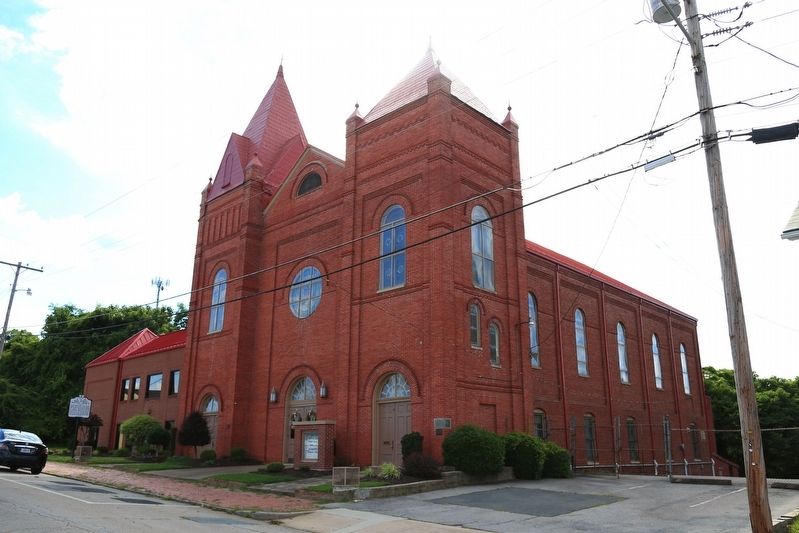Danville is known as the city of churches, their many lofty spires penetrating the skyline, but perhaps none occupies so commanding a position as the solid brick structure of High Street Baptist Church.
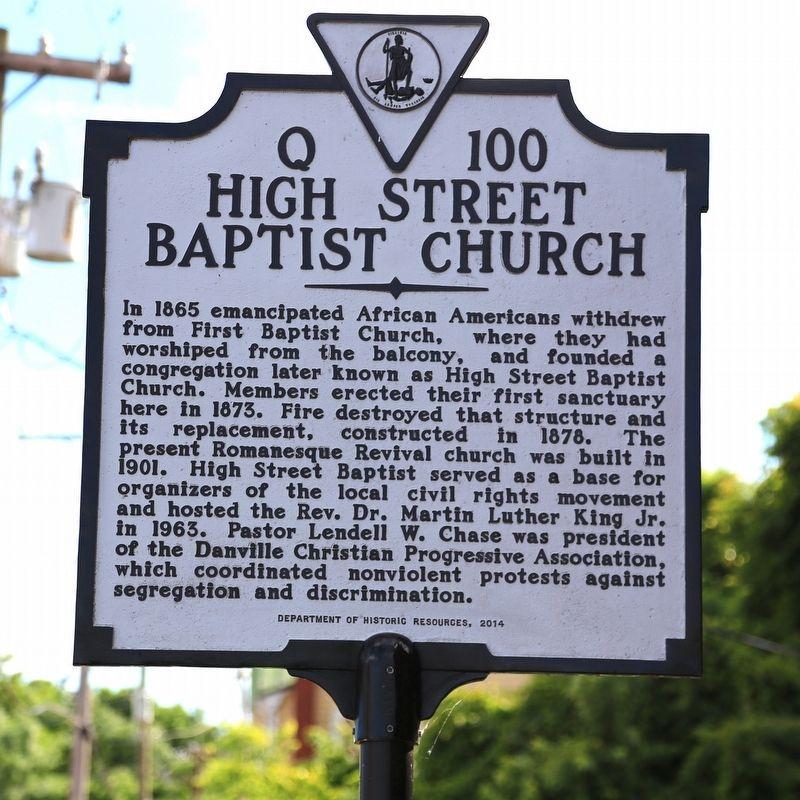 Travelers approaching the city from the east and west catch a glimpse of its red-topped pyramidal roofs. Its soaring towers overlooking the dwellings around it are a striking sight when observed from the corner of Main and Ridge streets just beyond the historic district.
Travelers approaching the city from the east and west catch a glimpse of its red-topped pyramidal roofs. Its soaring towers overlooking the dwellings around it are a striking sight when observed from the corner of Main and Ridge streets just beyond the historic district.
A good example of late nineteenth century Romanesque Revival architecture, it is in stark contrast to the lowly hospital in which the church had its beginnings, and a tribute to the stalwart ex-slaves who founded it, many of whose descendants worship here today.
High Street Baptist Church is one of several Danville churches which have grown from the original Baptist organization of former slaves who, immediately following the civil war, met in an old hospital situate on a high place in the southern section of town known as “Hospital Hill”. This was the hospital formerly used for sick Federal prisoners during the epidemic of smallpox and other diseases that struck while they were interned here during the war. It was located somewhere between the present Lee and Whitmell streets.
Afterwards the group began holding services in a warehouse located at the corner of High and Union streets, later erecting the first building on the site of the present church, according to the late Mrs. Hazel C. Slaughter, in her history of the church written on the occasion of its 102nd anniversary in 1967.
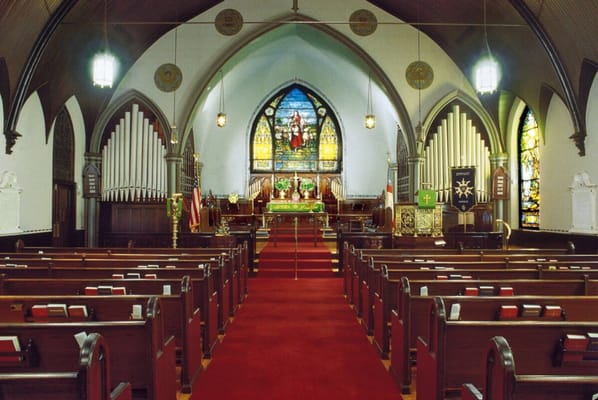
The present sanctuary is the third one erected on this site, two previous buildings having been destroyed by fire. The cornerstone reads, “Erected 1873. Burned 1878. Rebuilt 1878. Burned 1901. Rebuilt 1901.”
The earliest record that could be found of the church in the local clerk’s office is a deed bearing the date of February 28, 1881, recorded on June 10, 1881. It indicates that a lot fronting seventy feet on the western side of High Street was conveyed from R. W. Peatross, Commissioner in the suit of J. B. Tunstall vs. W.H. Tunstall’s Administrator and heirs to “Moses Green, Preston Watkins and Davis Crosby, Trustees of the first colored Baptist church of the town of Danville, Va.”.
In the acquisition of further tracts of land on High Street in later deeds, the church is referred to by its present name.
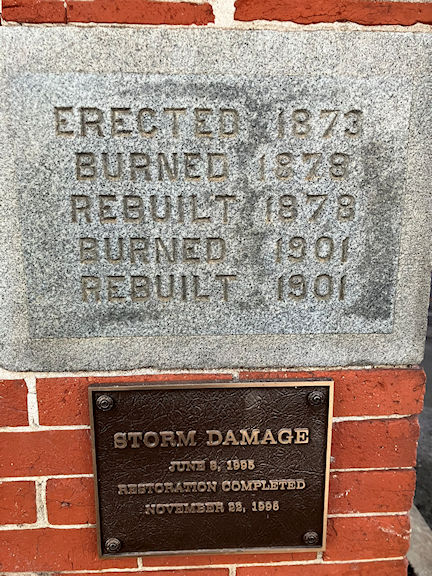 The above deed also sets forth that the lot was previously conveyed to Moses Green, W.H. Jones (who had resigned), and Jack Allen (deceased), then Trustees of said church, for a consideration of $700 and that the deed “was delivered to Pickett Scott for the church but was mislaid or lost without having been recorded and cannot having been found to be recorded.” Mrs. Slaughter in her history states that one of the faithful members of that first church, Patrick Wilson, donated the land.
The above deed also sets forth that the lot was previously conveyed to Moses Green, W.H. Jones (who had resigned), and Jack Allen (deceased), then Trustees of said church, for a consideration of $700 and that the deed “was delivered to Pickett Scott for the church but was mislaid or lost without having been recorded and cannot having been found to be recorded.” Mrs. Slaughter in her history states that one of the faithful members of that first church, Patrick Wilson, donated the land.
So, it is apparent from the records that the church was built and in 1878, burned and rebuilt, before legal title to it had ever been recorded.
Two church buildings on this site were not only raised by fire, but a cyclone sometime in the early 1880s partially destroyed the second building constructed here. An account of the fire which totally destroyed the second church is given by Mrs. Slaughter. It read, “This is the Bulletin that was issued March 22, 1901 concerning the fire. ‘A Big Fire is Raging—High Street Baptist Church is on fire and the chances are that the adjoining factory, formerly used by Keen and Jones, will be destroyed with the church. Jim Clarke (colored) one of the tinners in an attempt to escape was badly burned. It is not thought that he will die. The church was erected in 1878 by colored Baptists of the city and has taken the lead in religious work among the colored people of Danville. The church is fully insured with one of the local agents. It was valued between $15,000 and $18,000.” The same year, 1901, the church was rebuilt and is the sanctuary we see here today.
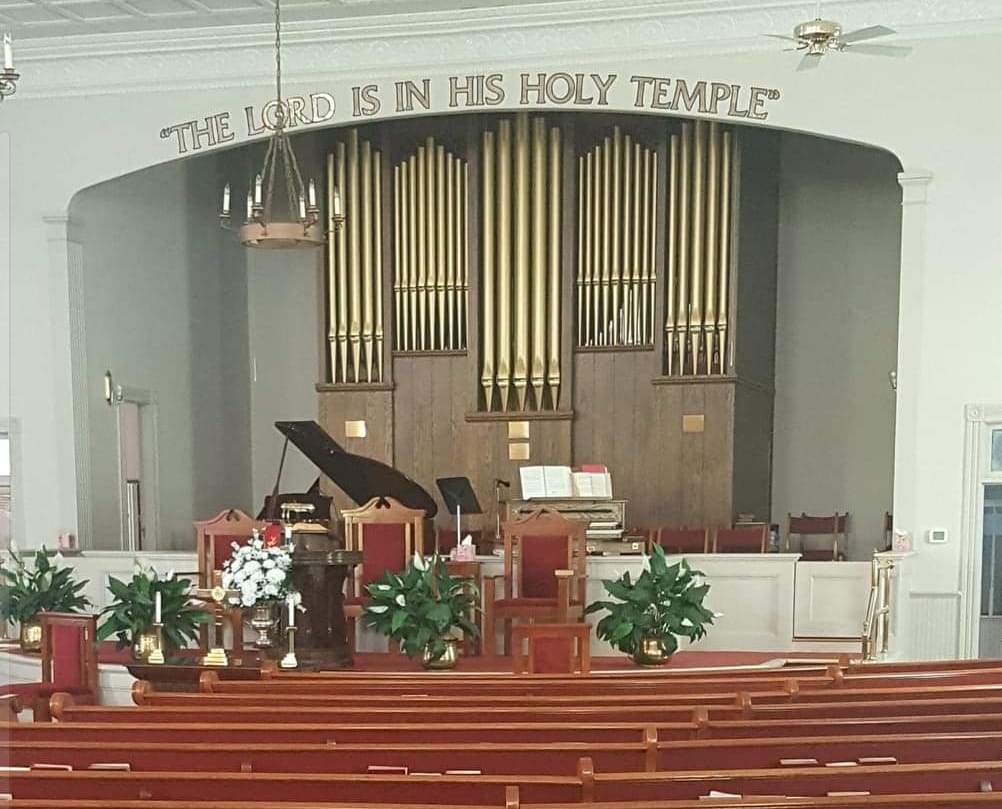
Once again on June 8, 1995, during a severe thunderstorm with tornado-like winds that destroyed trees on nearby Grove Street, the church received major damage.
Ripping into the roof at the back of the sanctuary, the high winds tore off rafters, splintering woodwork and completely demolished the altar and organ. Remarkably, the beautiful stained glass memorial windows withstood with only a few panels broken. All of the organ pipes but five and some of the keyboard and other parts were recovered from the debris and are being used in constructing a new organ.
This historic instrument was given in honor of William H. Claiborne, a long and faithful member of High Street, by Mt. Vernon Methodist Church where Claiborne served as sexton, when a new organ was installed in the 1940s. Manufactured by Hook and Hastings, it was believed to have been at Mt. Vernon since its construction in 1885 and was the oldest pipe organ in continuous active service in Danville. Plans to replace it were abandoned by High Street over twenty-five years ago when it was found by organ technicians to be an outstanding Instrument.
The first minister of the church was Rev. Harrison Scott, whose daughter, Celia, married Dr. Albert L. Winslow for whom Winslow hospital, which later housed the City Health Department on Betts Street, was named. The present minister is the Rev. Jerome Morris, a native of West Virginia, more recently from High Street Church in Martinsville, Virginia where his father was a minister for many years.
The church is especially proud that the first African-American foreign Baptist missionary to Africa, Solomon Cosby, came from High Street. His brother, David Cosby, was at one time organist for the church.
The congregation can boast, too, of being host to Dr. Martin Luther King, Jr., American clergyman and civil rights leader, when he spoke from the pulpit here in the 1960s. (For more on that, read to the end of this copied content.)
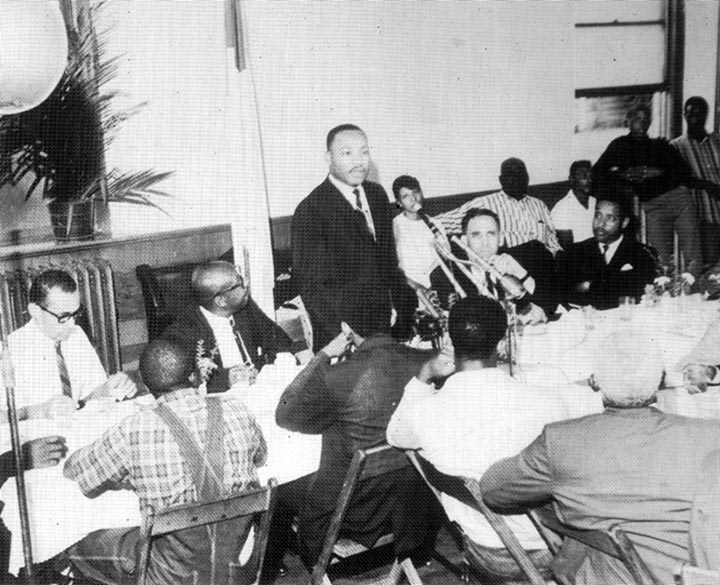
Complete restoration of the church is underway by the John W. Daniel Co., with Julian Swanson, who heads the Board of Deacons, serving as restoration chairman. Mr. Swanson served for twelve years on Danville’s Planning Commission.
The front of the structure with its two uneven-height towers topped by pyramidal roofs, and enhanced by the center round jewel crowned window, fan-shaped stained glass over the doorways and other memorial windows, remained unscathed.
The architectural ornamentation is achieved almost exclusively through the forming of geometrical patterns with projected and recessed brickwork. The monochromatic quality of the building adds to its appearance of solidity.
The Danville Historical Society during its preservation celebration in May 1996 presented the church an award for its restoration of this most interesting and important landmark.
Reproduced with permission from Victorian Danville – Fifty-Two Landmarks: Their Architecture and History © 1977 Mary Cahill and Gary Grant with edits and insertions for greater context.
Martin Luther King, Jr.s Visits to Danville and to High Street Baptist Church
[The following is from an article entitled To Make Real the Promise of Democracy: Martin Luther King, Jr., and the Struggle Against Police Brutality in Danville, Virginia, published by the Martin Luther King, Jr. Research and Education Institute at Stanford University]
After over a month of city officials violently rebuffing demonstrations, King visited Danville on 11 July and addressed the coalition of civil rights groups working in the area. During his speech, he said, “I’ve seen some brutal things on the part of policemen all across the South in our struggle, but very seldom, if ever, have I heard of a police force being as brutal and vicious as the police force here in Danville, Virginia.” Though he decided not to lead a march in the city, he reaffirmed his commitment to their struggle: “I am here to let the community know that I am with you as an individual, not only as the president of the Southern Christian Leadership Conference, but as a person concerned about the problems of this community and communities all over the South. And I come here to let you know that you have my full personal support.”
(For more context about the fight for Civil Rights in Danville, please see the link above for the entire article, see this article written by Val-Rae Christensen in cooperation with the Danville Museum of Fine Arts and History and Virginia Humanities, and “The Movement” at the Danville Museum of Fine Arts and History, now part of Virginia’s Civil Rights Trail. A link to the video produced by Karice Luck-Brimmer in cooperation with Danville Museum of Fine Arts and History and Virginia Humanities can be found through this link.)
